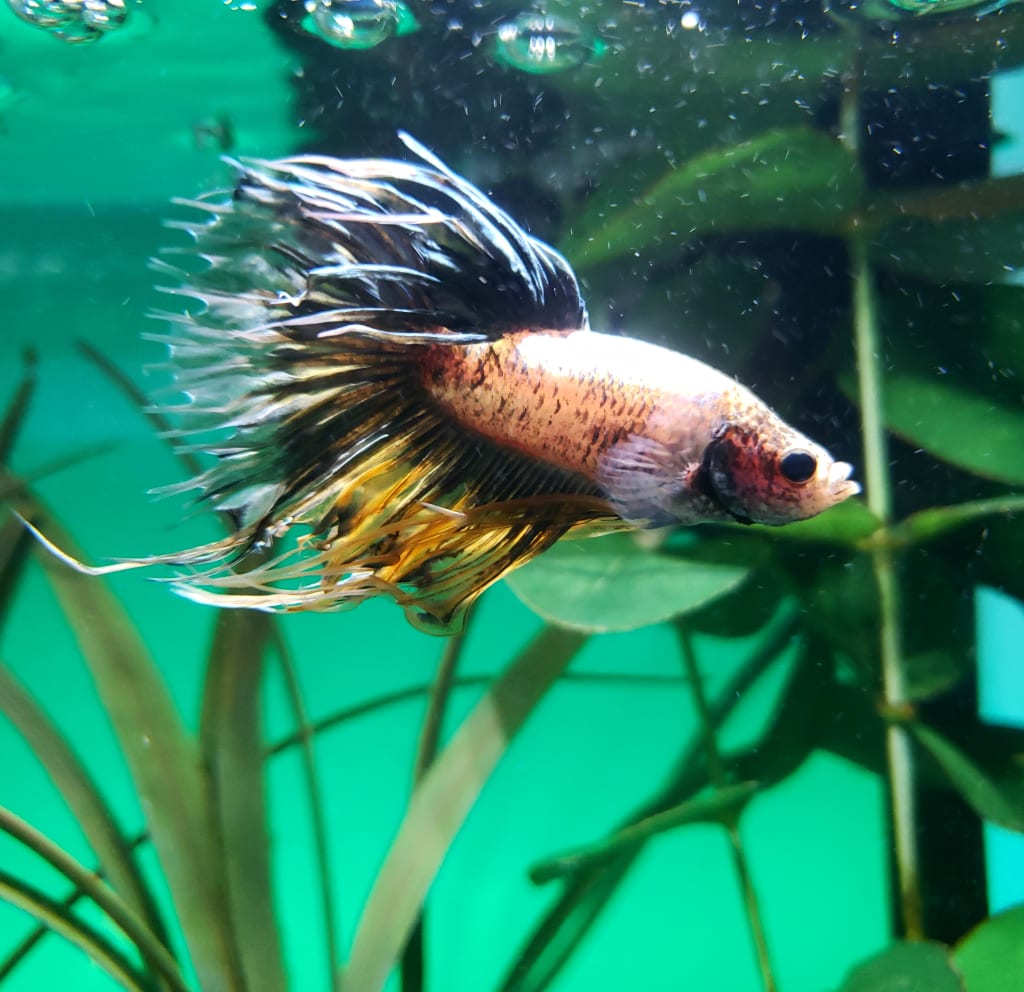
Many people buy betta fish because of their beautiful colors and flowing fins, and then stick them in tiny bowls thinking that that is good enough for their new fish. The fact is, though, that these tiny bowls are not adequate care for these fish. While they may survive in these bowls for a while, they are not truly living a happy life.
A quick note before we begin: if you're going to buy a betta fish for your young child, make sure you help them with feeding and water changes! Keep reading to see how to properly care for your new fishy friend!
Tank Size
The myth that bettas in the wild live in small puddles is simply not true. In the wild bettas live in rice patties, slow-moving rivers, and waters with lots of plants. While these are considered "shallow waters" they still have plenty of room to swim in any direction.
The minimum size tank a betta should be kept in is 2.5 gallons, which is larger than your average fish bowl. 5 gallons would be a happy medium, with a nice amount of room for the betta to swim, and for you to decorate. 10+ gallons gives them more space, and is easier to keep the water clean. The bigger your aquarium, the more wiggle room you have to keep the water clean and prevent toxins from building up.
Heater
Betta fish are originally from parts of Vietnam, Malaysia, Thailand, and Cambodia. Therefore, your Betta's water needs to be between around 76 to 80 degrees F. Unless your house is warm enough to keep that temperature naturally year round, you're going to need to get a heater. Heaters are quite inexpensive, and a cheap aquarium thermometer can make sure that your heater is doing its job properly. (Please note that keeping your fish by a window in direct sunlight in order to keep it warm is not a good idea, as the temperatures are highly unpredictable and most likely too hot.)
Filter
Fish produce waste, leftover food produces waste, and that waste has to go somewhere. The easiest way to keep your tank clean and pretty looking, as well as a happy toxic-free environment for your fish is a filter. The filter will help get rid of all the icky stuff and keep the tank clean. Just make sure that the filter water flow isn't too strong, as it can make it hard for your betta to swim properly. Pair this with weekly partial water changes, and you'll have a bright and happy betta in no time!
One other thing to look for is a good water conditioner. Make sure you read the directions on the bottle so you know the proper amount to add to your water. A good water conditioner will help remove anything harsh in your tap water that could harm your fish.
Tank Mates
Betta fish are also referred to as Siamese fighting fish, so as you can imagine they can be aggressive towards other fish, and even their own kind. You absolutely cannot put two males together, and even having a Male and a female together can be risky. Your best bet is to just to stick with one betta per tank, or to get a large tank and add dividers to keep them separate from each other.
If you're going to have a 10+ gallon tank you could possibly add some snails, cory, catfish, or similar, but if you're going to do that there are a couple things to keep in mind. Research if they are compatible personality and care requirement wise, quarantine the new fish before you add them to the betta tank, and have a separate tank ready in case they don't get along and need separation. Keep a close eye on them until you are sure they get along and have lots of hiding places!
Food
Betta fish are pretty simple to feed. You can buy commercial betta food at almost any pet store, and one container will last you forever. Flake food can be messy so if you pick this type make sure to remove uneaten food quickly. Tiny pellets make less mess, and can be dropped in the tank one by one until the betta is full/had enough food. You can also occasionally feed your betta frozen/freezedried bloodworms as a treat. Your betta will not eat/survive off of plants, so please make sure to buy the appropriate food.
It's most common to feed your betta once or twice a day, about three pellets, or how much it can eat in two minutes. Be careful to not overfeed your betta as that can lead to health problems. Missing a feeding here or there isn't a big deal, but try to keep a proper schedule.
Decorations
When it comes to decorating your betta fish's tank, your options are endless! You can go natural with live plants, or the opposite—a neon glow in the dark tank. This is really up to you and what you're looking for. Including large leaves (like almond leaves) for your betta to rest on is appreciated. And any plants/decorations you use (real or fake) should have no sharp edges or spikes, as these can tear your betta's delicate fins. Get creative and create a tank that complements your lovely fish and adds to your room.
Airstones
Having an airstone in your betta tank is not necessary. Betta fish will come to the surface for a gulp of air if needed. However, bettas generally do enjoy airstones, and like "playing" in the bubbles by swimming through and around them. So while they are not necessary, if you want to add some fun bubbles to your tank you can, and your fish most likely will enjoy it. As a bonus, you can enjoy watching them play around!
Final Notes
While this seems like a lot of information to take in, it's quite simple and you'll have it down in no time. While there are a couple pieces of "equipment" you'll need to start your tank, after that your fish will be easy and cheap to take care of after that, and will be thankful for the effort you put in. Set your tank up, and then go out and find your new colorful little friend. Enjoy!
About the Creator
Gracie R.
Owner of the website www.reptileworldfacts.com, and an avid animal lover. Check out our website for more reptile articles and to be able to find all of our socials!
Gifts to help me be able to continue writing are always appreciated.






Comments
There are no comments for this story
Be the first to respond and start the conversation.